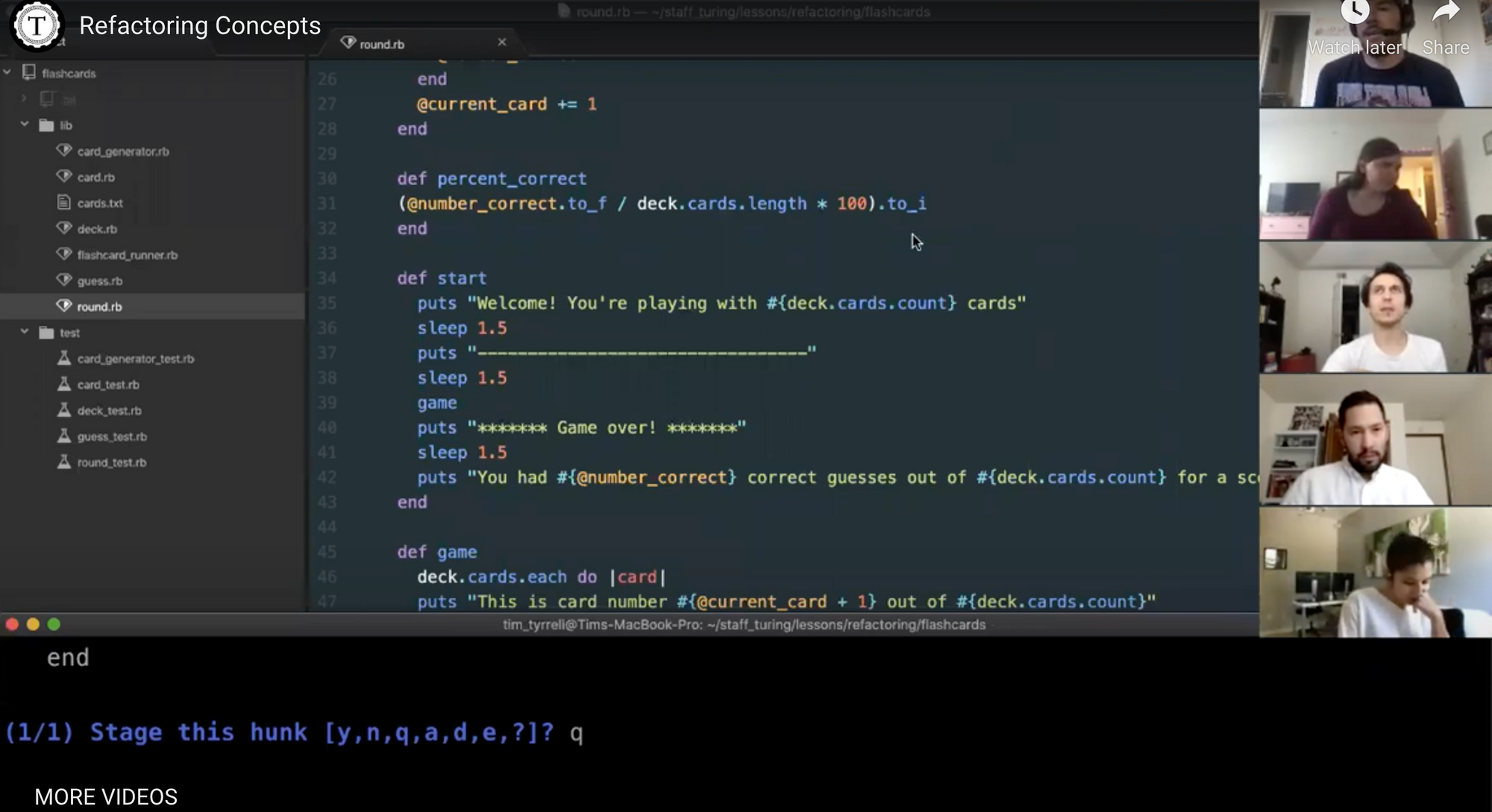Take a Peek into Turing’s Remote Classrooms
Turing approaches online learning with student success as the top priority.

Online classes give you the ability to learn from anywhere, but sometimes this type of learning can feel isolating and self-directed. When Turing began operating as a remote school, we knew we had to keep the community feel and support that had helped over 1000 alumni find successful careers as software developers.
At Turing, all classes are instructor led in real time via Zoom to ensure students can be engaged and get help when they need it. To gain a better understanding of what that looks like, watch the videos of a few online classes below and read about the instructional practices in play, annotated by our Try Coding Instructor, Amy Holt.
Back End Mod 1* with Tim - Refactoring Concepts:
*Turing’s 7 month programs are broken down into four, six week long modules.
This Back End Mod 1 class helps students learn the tenants of refactoring code and gives them some practice on a project they’ve already built.
During the first minute of the video, Tim, the instructor, is setting up students to have small group discussions in Zoom breakout rooms. Breakout rooms allow students to have smaller group discussions or work sessions, similar to how you would if sitting around a table in a physical classroom. When students are sent into breakout rooms, they receive directions about what to do and any associated resources in the Slack channel they are a part of. While students are in breakout rooms, the instructors typically join each for a few minutes to check on groups progress and answer questions as they come up (similar to an instructor circulating in a physical classroom).
Between minutes 1:00-6:00 of the video, Tim calls on various students to share with the whole class on what their small groups discussed. He builds on what each student shares and connects those contributions to the key points of the lesson.
Around 6:00, Tim screen shares his code and gives an overview of the challenge he will be working through to model the technical concepts as well as his process. He works through the challenge for the next 7+ minutes.
Around 9:00, Tim mentions that students can watch or code-along. You can see that some students appear to be taking notes in a notebook and some are looking back and forth at different screens, meaning they are probably coding along.
During the next couple of minutes, Tim is modeling how he thinks through the problem. That problem solving process is a critical part of students growth and something that is weaved into instruction, coaching, and feedback.
Around 13:00, Time shares a tip for keyboard efficiency.
After modeling a potential solution to this challenge and highlighting some best practices along the way, Tim opens it up for questions or comments. Several students unmute their mic and ask questions; it’s a pretty rich and interesting discussion; some touch on very technical pieces of the code and some are more related to general best practices for development.
Around 22:30, the students are given a break. Even if a class is scheduled for 2-3 hours, instructors provide 5-10 minute breaks every 30-40 minutes. This comes from the Pomodoro Technique.
The class finishes with another breakout room session, then a student screensharing and problem-solving through a small challenge with the help of Tim and other students.
Back End Mod 1 with Mike:
This Back End Mod 1 class helps students learn the foundations of testing their Ruby programs.
Class starts with students sharing out about their experience with different testing tools. Then Mike, the instructor, shares some rationale for the importance of software testing as a practice.
From 2-10 minutes, Mike shares the conventions for the file structures so students know how to set up their projects, then answers some questions that are brought up from that.
At about 10 minutes in, Mike screenshares his text editor and terminal to model setting up the testing framework Minitest, explaining what each part of the setup does for us. Then, he answers any clarifying questions this intro has brought up for students.
Around 19:30, Mike starts live-coding an actual project to show all of the topics he previously shared, in action. He thinks aloud to share his rationale for decisions, and stops frequently to open it up for questions.
At about 35:00, Mike put a question in the “parking lot” because it was a bit out of the scope of the goals for this lesson. This means that Mike will answer the question over Slack after the lesson or address it in an upcoming lesson.
Front End Mod 3 with Leta:
This Front End Mod 3 lesson is an introduction to building a server with Node and Express. Since these students are over half-way through their time at Turing, the instructor is able to reference a lot of background knowledge they’ve acquired.
Leta, the instructor, starts class off with reviewing the relationship between a Front End and a Back End, which students have had some time in past modules and lessons to internalize, then gets a little more specific about the role of a server.
At minute 2:00 of the video, Leta shares what students will be doing over the course of the 2-hour lesson so they know where they are headed, clearly sharing all the technologies they will be utilizing.
At 3:30, Leta gives the students “a short pom” and stops the recording. Class begins again around 4:05. Even if a class is scheduled for 2-3 hours, instructors provide 5-10 minute breaks every 30-40 minutes. This comes from the Pomodoro Technique.
At 4:40, Leta screen shares an app where she can whiteboard concepts being discussed and students follow along taking notes.
At 9:25, Leta poses a question to the class and asks to think about it. She gives about 10 seconds of wait time, then calls on a student to share out. Students who aren’t called on share responses in the chat. Similarly, at 11:25, Leta poses another question and asks students to draw on their background knowledge to make connections to a new vocabulary word. She calls on a student who shares out.
At 27:30, Leta starts building a server from scratch. She shares her screen and types out a step-by-step guide as she goes, which students can reference later.
Front End Mod 1 with Hannah & Scott:
In this class, Hannah and Scott co-teach and model best practices for how to collaborate over GitHub. GitHub is a common platform that hosts code projects, and using it, along with Git, is an important skill that we support students in developing while at Turing.
Hannah starts by modeling the steps that a user can take to start a collaborative workflow over GitHub. She invites Scott, another instructor, to a project.
At minute 2:10, Hannah answers a question that was typed into the chat feature of Zoom regarding GitHub followers.
At 3:45, Scott takes over the screen share and talks through the first steps he would take as a collaborator. As some students are new to Macs and this is in the first week of Mod 1, Scott makes sure to explicitly share what keyboard shortcuts he uses. During the next 15 minutes, Scott models his workflow and talks through it. Students are encouraged to share questions over their microphone or via chat, which Hannah is monitoring.

